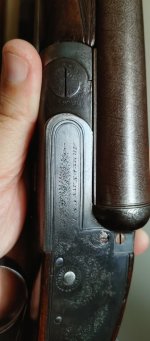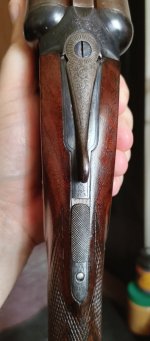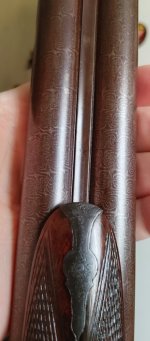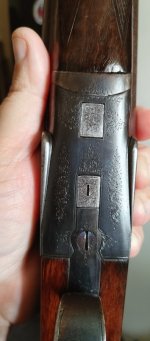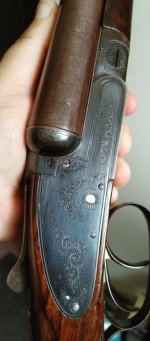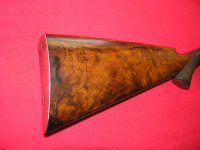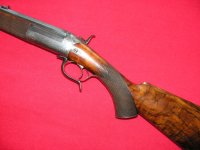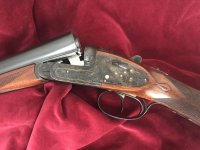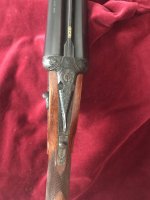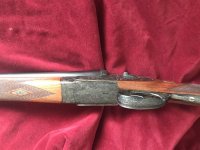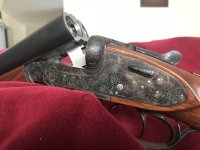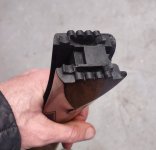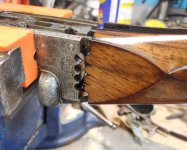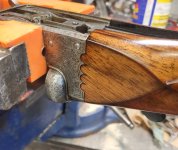Part of the allure of British guns is the joy one has in using them, and, in some cases, just owning them. Quality guns, and good stories.
Back to singles, which could be made to ‘Best’ standards, if the client wished it, and had a use for one. Admittedly, it is hard to get out of the mindset that all hinge-action single-shots are cheap beginner, utility guns. But look at this Dickson, hardly a ‘truck gun’!
John Dickson & Son is famous for its trigger-plate round-action doubles, starting in 1880, but the history of the firm is much older. John Dickson was born around 1795, and in 1806, at the age of 11, he was apprenticed for 7 years to the gunmaker James Wallace at 187 High Street, Edinburgh. In 1828, Wallace moved to 63 Princes Street, and by 1830, Dickson was listed as a gun maker at that address. In 1858, Dickson made his first breech-loading gun, a double-barreled pin-fire number 1928.
Gun number 2820, pictured here, is a 12-bore pin-fire with a double-bite screw grip action. It was completed in 1875 and was one of the last five pin-fires made by the firm. It was made entirely in-house at a time when the firm employed 18 men and boys, though an Edinburgh outworker may have completed the barrel browning. Unfortunately, the sales ledger no longer exists, so it is impossible to trace the original owner. The Edinburgh firm of John Dickson & Son made 460 pin-fire guns between 1859 and 1875, but of these, only 10 were singles.
The gun sports a back-action lock, a dolphinfish-styled hammer with an offset nose, London proofs, and the 31 1/16" fine damascus barrel still retains its spotless bore. The barrel is signed
"John Dickson & Son, 63 Princes Street, Edinburgh." In pure gunmaking excess, it has two symmetrical, beautifully-shaped percussion-style fences, hand chiselled, neither of which is in any way functional. It also has a well-figured stock and a horn fore-end cap. Unusual for a pin-fire, but in keeping with its late manufacture date, is a nicely contoured chequered horn butt plate. Solidly built, the gun weighs 6 lb 7 oz. Sadly, I do not know the history behind the gun or the purpose for which it was meant. Since guns of this quality were made on demand, the client must have had a good reason for a single barrel, and it wouldn’t have been to save money – this gun would have been more expensive than a competitor’s top double. By the mid-1870s, cheaper machine-made breech-loading guns were being made in Birmingham, including singles. These would have been available from larger firms and small-town gunmakers, so if a cheap single was wanted, one could be found by this time.
Here is Mr Dickson, and a photo of his workshop, likely early 20th century. Not much would have changed from when the Dickson pin-fire was made.
The next single is an earlier gun, though it can’t be precisely dated. On the surface, this single-barrel pin-fire gun signed
"H. W. Whaley, Strood, Kent" is a fine-looking gun that has undergone period repairs, and perhaps more recent (and less skilled) repair or restorative work. The dimensions are for a person of typical stature, and the level of decoration is in keeping with a second- or third-quality London gun or a first- or second-quality gun of provincial make (Strood is a small town about 40km east of central London). The action is the design of Robert Adams of London, conforming to his patent No. 285 of 3 February 1860, though it is unmarked. In a letter to the weekly sporting paper
The Field dated 6 February 1864, Adams stated his guns were
"my own patent, made on my own premises, and under my own supervision" when challenged about the origins of his pieces, clearly establishing his 76 King William-street workshop as the builder and purveyor of his patent action. However, a number of provincial makers sold guns with Adams actions, possibly under some arrangement with Adams.
I expected to find a patent mark or a patent-use number on the action, so I was surprised to find no markings of any kind on the action, not even provisional proofs. The story got darker, finding no proof marks on the barrel, only a bore stamp (15). The 28 1/16-inch barrel is of twist construction and is half-16-sided to half-8-sided towards the breech, suggesting it might have been repurposed from a muzzle-loader; the chamber is bored for the 14-gauge cartridge. Whatever marks might have been on the original barrel were gone, and once rebuilt, it was never submitted for proof to the London or Birmingham Proof House, an offence under the Gun Barrel Proof Act of 1855.
With no way to precisely date the gun, it was possibly made after the Adams patent lapsed. However, there would have been far easier and more robust designs to copy by such time than the Adams. The Adams action was popular in the early 1860s; a correspondent wrote about the Adams action to
The Field on 29 November 1862, stating,
"I have used one for the past two seasons made by Mr Adams, of King William-street, City; whose principle, for simplicity and strength, I consider the best out." He further noted,
"last season I fired from this gun 2000 shots, and over 1000 this season," giving an idea of how pin-fire guns were used in the field. He noted
"another great advantage in Mr Adams's breech-loaders, which is, the absence of that mass of iron-work at the junction of the barrel and breech, which makes it as light and handy as any muzzle-loader." Adams's guns under this patent were of the bar-in-wood type, hiding a narrow action bar and the hinge beneath the woodwork. Some of his guns had a permanently attached fore-end, though this one has a removable one. Making any bar-in-wood gun is not for the faint of heart, and this is the only bar-in-wood single-barrel pin-fire gun I've ever come across, in my hands or in print. It has an "island lock," and very little metalwork is apparent, giving it the look of a fine muzzle-loading gun.
The name and address on the gun, Henry Watson Whaley of Strood, Kent, offers another avenue to the investigation. He was born in Lynn, Norfolk, around 1805. His father, John, was born in 1781 and was a gunmaker by trade, and Henry likely apprenticed under him. John Whaley & Son traded in High Street, Strood, starting in 1831. Henry married in 1834, but happiness was replaced with trouble in the business. In June 1839, the company was dissolved, with both the father and son being sued and ending up in the notorious Marshalsea debtors' prison that year. Around 1844, Henry resumed the business under his name at 46 High Street. There must have been a severe falling-out between Henry and his father, as on 13 November 1849, he took out an advertisement in the
South Eastern Gazette announcing
"that John Whaley, Sen., his father, has left him, and has no connection whatsoever with his business, and that the said John Whaley, Sen., is not authorized to receive any money or take orders on account of Henry Watson Whaley, from this date." Nothing much is known about the business, but Henry was recorded as a master gun maker. He did not have any children to continue the business. In the 1851 census, he is recorded as having a 15-year-old apprentice, Henry Jackson, and in the 1861 census, another 15-year-old apprentice, George B. Richardson, is listed as living with him above the workshop. Henry died in 1881, and the business, gun maker and cutler, was continued by his workman Edward Palmer until around 1894 (Palmer may have apprenticed under Henry).
Unfortunately, there is no way of knowing if Robert Adams's workshop made the action, or if it was made under licence (or not) by Henry Watson Whaley at the High Street address. From the possibly repurposed barrel, I presume it was fitted and the gun assembled by Whaley; the special-order nature of the gun might help explain why the action and barrel were never proofed, being a one-off order, perhaps made under time pressure. In any case, it is fine work and aesthetically pleasing. 14 gauge was popular then, and the single-barrel and bar-in-wood construction made for a light gun at 5 pounds 10 ounces. The silver stock escutcheon is unmarked, leaving no clue as to the original owner; the gun is unnumbered, which is not unusual for a gunmaker producing a minimal number of guns in a year, and in any case, no Whaley records have survived. The period repair, an inletted pinned metal strap straddling the hand and comb, shows that someone wanted to keep the gun in the field despite a broken stock, perhaps sometime after the pin-fire system was out of fashion. Two other repairs, filler added around the lock and a possibly replaced fore-end tip of darkly-stained wood instead of horn, suggest later amateur repairs or restoration work of a lower quality, perhaps when the gun was relegated to wall-hanger status. Despite these minor blemishes, the gun is interesting, unusual, and storied. The stock is nicely figured, and the flat-top chequering is well executed. Exactly who made the gun cannot be determined; neither is the reason for its construction, nor why it escaped the proof house. Few Whaley arms of any type (by father or son) have surfaced, so it is impossible to know if it was typical in build or quality. Perhaps something will turn up that will help fill out the story.
Next up, singles as a result of conversions.


































































